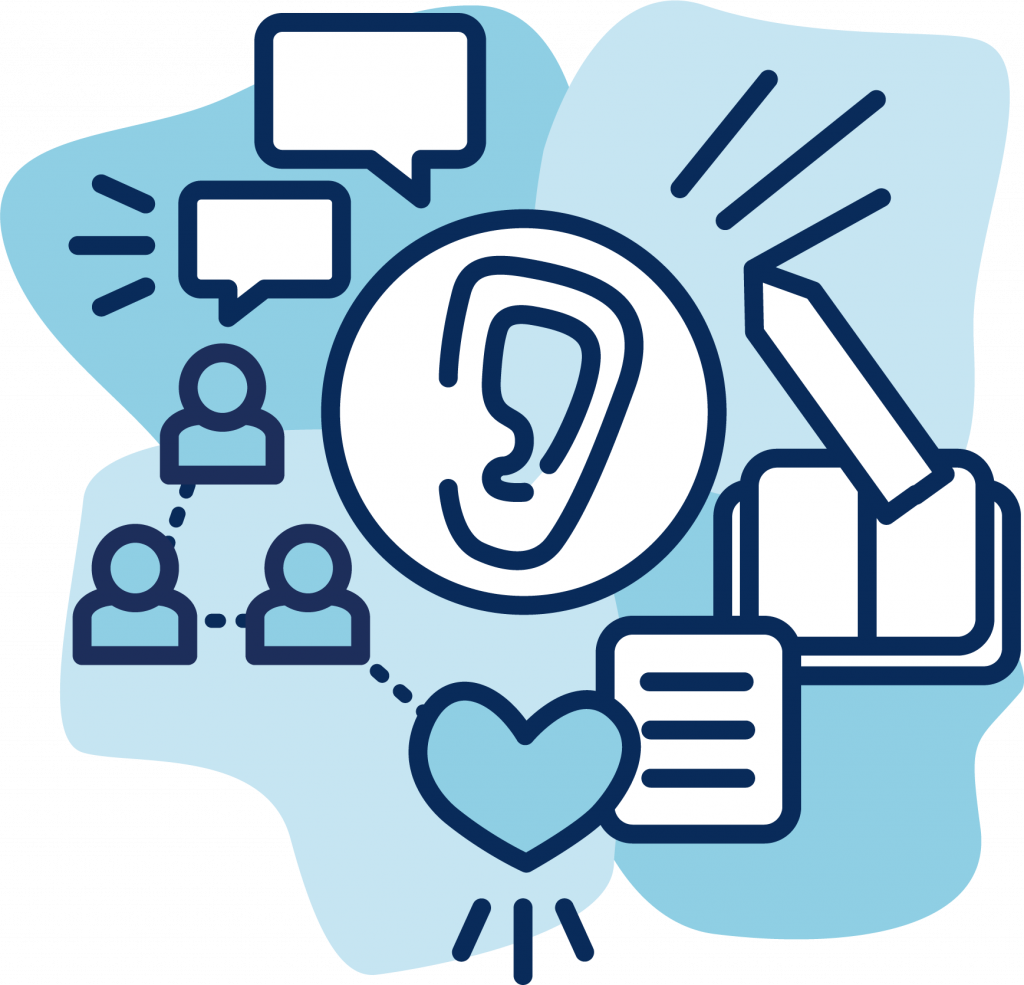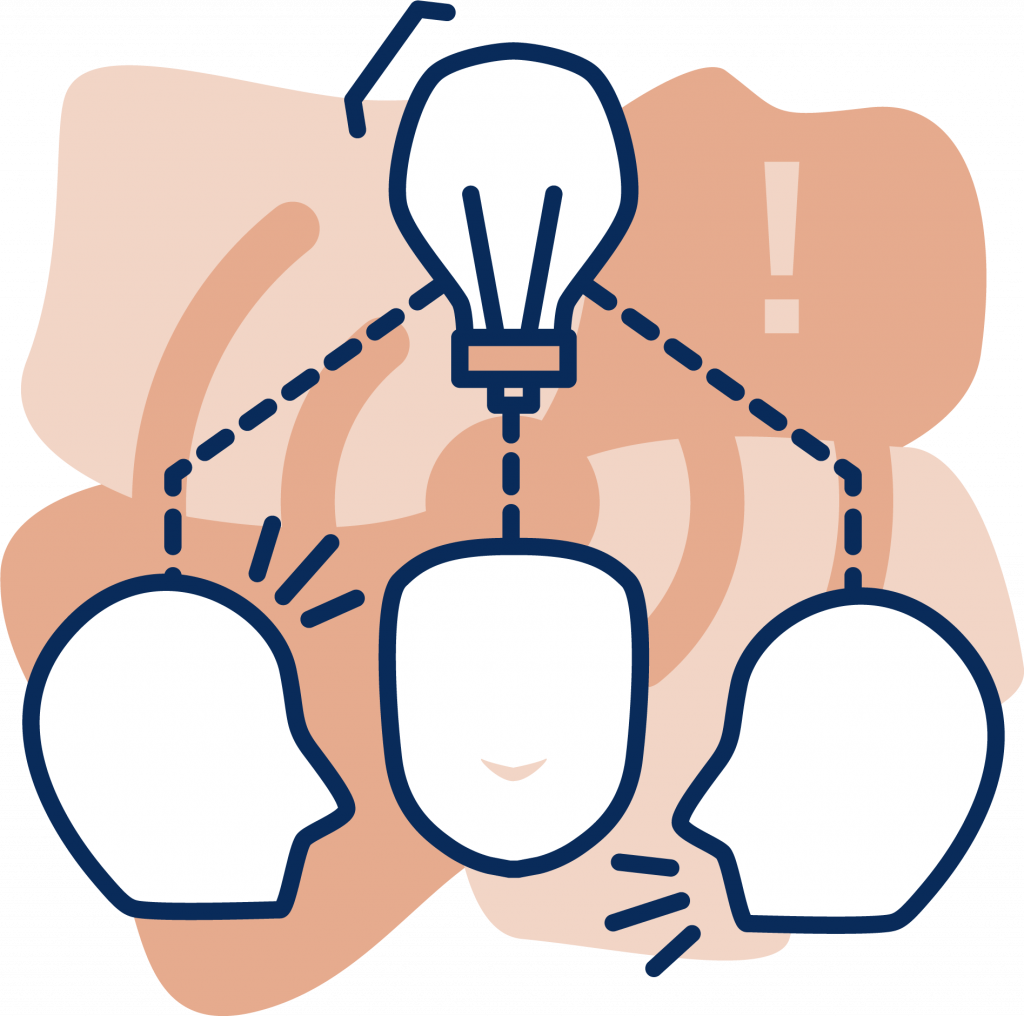

Written By Betelehem Gulilat, Content Writer
Illustrated By Vlada Gorchkova, Digital Storyteller
Part of what makes us human is the need for forming connections that make us feel truly heard and understood. There is a sense of belonging that comes with feeling supported that allows us to deeply understand ourselves, one another and discover what we find meaningful in our lives. This wouldn’t be possible without the help of active listeners. Through the art of active listening, a simple conversation can inspire change, strengthen relationships, and lead to innovation.
Active listening is fundamentally the ability to attentively understand the meaning behind the words of the speaker without the intrusion of your own thoughts, opinions, and judgment on the matter. Unlike the simple act of listening to words, active listening involves understanding why the person may be feeling a certain way, where they are coming from, and the message you are receiving. (1)

The Wonders of a Listening Ear
When we are listening to one another, we allow individuals to speak and participate in meaningful conversations. It can also be a powerful tool in our lives whether it be at the workplace, school, or within our own relationships. Listening is part of the jigsaw puzzle of communication that is easily overlooked, leaving conversations feeling unproductive or one-sided. While it may seem like a small facet of how we go about our lives, there are many ways active listening can make a difference.
It helps us form deeper connections
Actively listening allows us to form a deep sense of connection in which the other individual feels heard, and builds a sense of trust after receiving validation. A study conducted at the University of Toronto found a difference between listening to understand and listening to respond. Participants who “listened to understand” had a greater sense of satisfaction in their interpersonal relationships. (2)
It helps us understand ourselves and one another
Listening is contagious in that being genuinely listened to inspires you to take turns becoming the active listener. This presents the opportunity to take turns understanding ourselves and how we feel about a given situation by getting the chance to hear each other’s perspectives out loud from a clearer, more sensible point of view. This is the key to human relationships whether it be personal or professional.
It helps us create real change
A new level of understanding is unlocked through active listening, where you can understand the other side of a person or an argument in a way that can challenge your preconceived notions and transform your own perspective. This change in perspective starts with the individual and can progressively lead to organizational and system-level change. Within organizations, leaders who practice active listening have been shown to improve workplace performance, productivity, clarity, creativity, and well-being for the listener, speaker, and overall organization. (3)
This may all sound like a lot of work and is the reason why it is called “active” listening. However, this misconception that listening is a natural ability needs to be challenged. Everyone has the ability to truly listen, and let’s agree that actively listening – especially in this day in age – takes effort. Like a muscle, listening can be exercised with people we interact with daily. The more it is exercised, the easier it will become to activate.
How to Be a Better Active Listener

At the Innovation Hub, design research goes hand-in-hand with active listening. It is a skill design researchers hone after interviewing dozens of individuals with diverse backgrounds, experiences, and perspectives of their own. Below is a list of tips to help you actively listen the next time you have a conversation with your colleague, friend, participant, or any individual you may come across.
- Be open to change: When entering a conversation, Carl Rogers, a well-renowned psychotherapist and founder of person-centered therapy, believes that to truly listen means being open to the transformation of your thought, belief, opinion, and ultimately yourself
- Replace judgment with curiosity: To genuinely listen, there needs to be an intent of wanting to understand the other person. This involves avoiding interrupting, agreeing, disagreeing, or thinking of how to respond to their response
- Ask open-ended questions: Are you asking good questions? Good questions guide conversations and can deepen the understanding of what the other person wants, needs, and feels. Some examples of open-ended prompts could be: ‘Tell me more…’, ‘How do you feel…’, ‘Why is that?’…
- Paraphrase and summarize: To help confirm whether you truly understand the other person, paraphrasing and summarizing informs the speaker that you have received the message while asking whether your interpretation is correct and/or needs more clarification
- Practice, practice, practice: Remember that listening is not a natural gift, but a skill. With practice, anyone can become a good listener
If we can all practice the art of active listening, it can become a powerful tool that brings out the best in each one of us and transforms our society for the better. Imagine if you and everyone you interact with were active listeners – what a utopian world it would be.
Some Resources on Active Listening
- Books
- Videos
References
- Murphy, K. (2020, January 9). Talk less. listen more. here’s how. The New York Times. Retrieved November 29, 2021, from https://www.nytimes.com/2020/01/09/opinion/listening-tips.html
- Raab, D. (n.d.). Deep listening in personal relationships. Psychology Today. Retrieved November 29, 2021, from https://www.psychologytoday.com/us/blog/the-empowerment-diary/201708/deep-listening-in-personal-relationships.
- Kluger, A. N., & Itzchakov, G. (2021). The power of listening at work. Annual Review of Organizational Psychology and Organizational Behavior, 9(1). https://doi.org/10.1146/annurev-orgpsych-012420-091013
0 comments on “The Art of Active Listening”